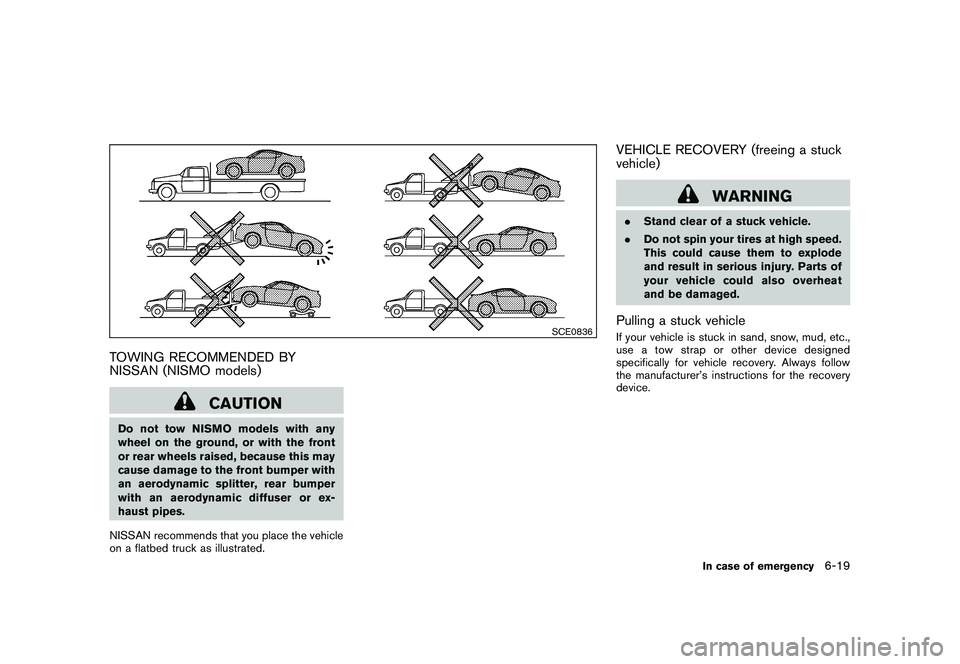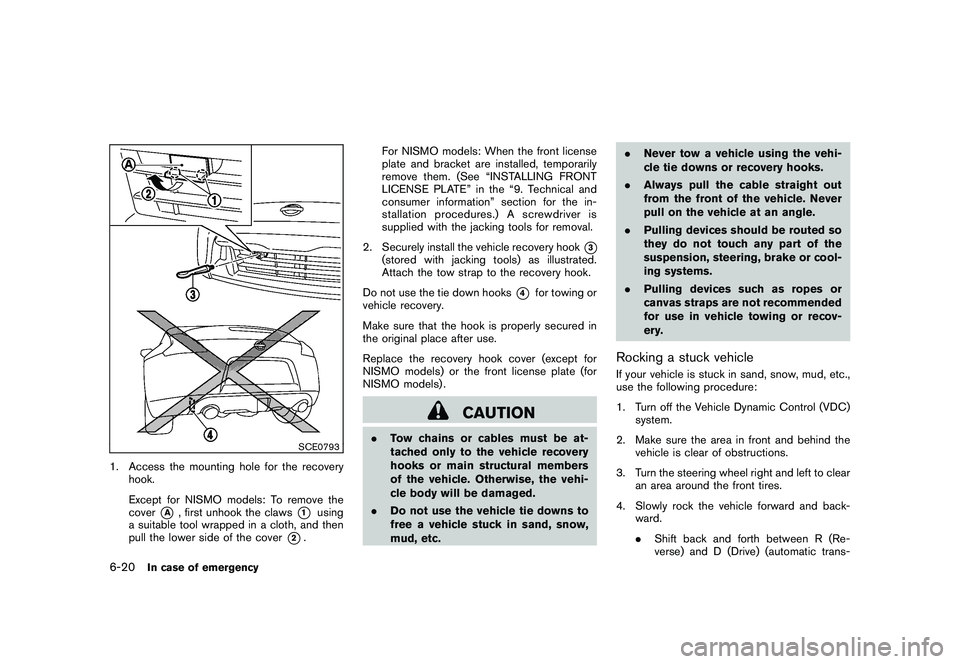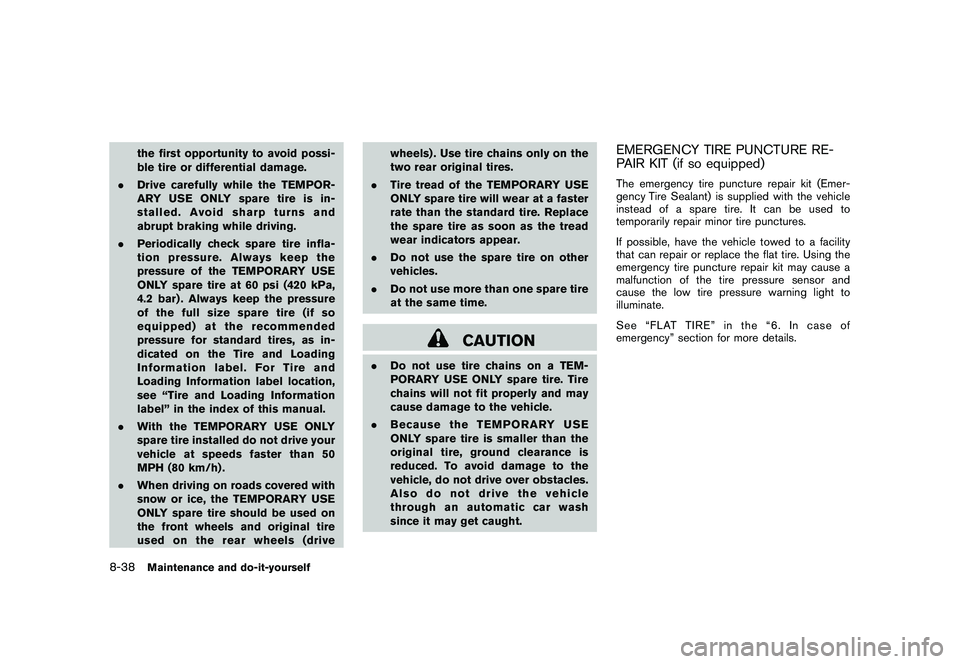2011 NISSAN 370Z COUPE tow
[x] Cancel search: towPage 333 of 419

Black plate (331,1)
Model "Z34-D" EDITED: 2010/ 7/ 27
SCE0836
TOWING RECOMMENDED BY
NISSAN (NISMO models)
CAUTION
Do not tow NISMO models with any
wheel on the ground, or with the front
or rear wheels raised, because this may
cause damage to the front bumper with
an aerodynamic splitter, rear bumper
with an aerodynamic diffuser or ex-
haust pipes.
NISSAN recommends that you place the vehicle
on a flatbed truck as illustrated.
VEHICLE RECOVERY (freeing a stuck
vehicle)
WARNING
. Stand clear of a stuck vehicle.
. Do not spin your tires at high speed.
This could cause them to explode
and result in serious injury. Parts of
your vehicle could also overheat
and be damaged.Pulling a stuck vehicleIf your vehicle is stuck in sand, snow, mud, etc.,
use a tow strap or other device designed
specifically for vehicle recovery. Always follow
the manufacturer’s instructions for the recovery
device.
In case of emergency
6-19
Page 334 of 419

Black plate (332,1)
Model "Z34-D" EDITED: 2010/ 7/ 27
SCE0793
1. Access the mounting hole for the recoveryhook.
Except for NISMO models: To remove the
cover
*A
, first unhook the claws
*1
using
a suitable tool wrapped in a cloth, and then
pull the lower side of the cover
*2. For NISMO models: When the front license
plate and bracket are installed, temporarily
remove them. (See “INSTALLING FRONT
LICENSE PLATE” in the “9. Technical and
consumer information” section for the in-
stallation procedures.) A screwdriver is
supplied with the jacking tools for removal.
2. Securely install the vehicle recovery hook
*3
(stored with jacking tools) as illustrated.
Attach the tow strap to the recovery hook.
Do not use the tie down hooks
*4
for towing or
vehicle recovery.
Make sure that the hook is properly secured in
the original place after use.
Replace the recovery hook cover (except for
NISMO models) or the front license plate (for
NISMO models) .
CAUTION
. Tow chains or cables must be at-
tached only to the vehicle recovery
hooks or main structural members
of the vehicle. Otherwise, the vehi-
cle body will be damaged.
. Do not use the vehicle tie downs to
free a vehicle stuck in sand, snow,
mud, etc. .
Never tow a vehicle using the vehi-
cle tie downs or recovery hooks.
. Always pull the cable straight out
from the front of the vehicle. Never
pull on the vehicle at an angle.
. Pulling devices should be routed so
they do not touch any part of the
suspension, steering, brake or cool-
ing systems.
. Pulling devices such as ropes or
canvas straps are not recommended
for use in vehicle towing or recov-
ery.
Rocking a stuck vehicleIf your vehicle is stuck in sand, snow, mud, etc.,
use the following procedure:
1. Turn off the Vehicle Dynamic Control (VDC)
system.
2. Make sure the area in front and behind the vehicle is clear of obstructions.
3. Turn the steering wheel right and left to clear an area around the front tires.
4. Slowly rock the vehicle forward and back- ward.
.Shift back and forth between R (Re-
verse) and D (Drive) (automatic trans-
6-20
In case of emergency
Page 335 of 419

Black plate (333,1)
Model "Z34-D" EDITED: 2010/ 7/ 27
mission models) or 1st and R (Reverse)
(manual transmission models) .
. Apply the accelerator as little as possi-
ble to maintain the rocking motion.
. Release the accelerator pedal before
shifting between R (Reverse) and D
(Drive) (automatic transmission models)
or 1st and R (Reverse) (manual trans-
mission models) .
. Do not spin the tires above 35 MPH (55
km/h) .
5. If the vehicle cannot be freed after a few tries, contact a professional towing service
to remove the vehicle.
In case of emergency
6-21
Page 341 of 419

Black plate (339,1)
Model "Z34-D" EDITED: 2010/ 7/ 27
after the cleaner is applied.
CHROME PARTSClean chrome parts regularly with a non-
abrasive chrome polish to maintain the finish.TIRE DRESSINGNISSAN does not recommend the use of tire
dressings. Tire manufacturers apply a coating to
the tires to help reduce discoloration of the
rubber. If a tire dressing is applied to the tires, it
may react with the coating and form a com-
pound. This compound may come off the tire
while driving and stain the vehicle paint.
If you choose to use a tire dressing, take the
following precautions:
.Use a water-based tire dressing. The coat-
ing on the tire dissolves more easily with an
oil-based tire dressing.
. Apply a light coat of tire dressing to help
prevent it from entering the tire tread/
grooves (where it would be difficult to
remove) .
. Wipe off excess tire dressing using a dry
towel. Make sure the tire dressing is
completely removed from the tire tread/
grooves. .
Allow the tire dressing to dry as recom-
mended by tire dressing manufacturer. Occasionally remove loose dust from the interior
trim, plastic parts and seats using a vacuum
cleaner or soft bristled brush. Wipe the vinyl and
leather surfaces with a clean, soft cloth dam-
pened in mild soap solution, then wipe clean
with a dry soft cloth.
Regular care and cleaning is required in order to
maintain the appearance of the leather.
Before using any fabric protector, read the
manufacturer’s recommendations. Some fabric
protectors contain chemicals that may stain or
bleach the seat material.
Use a cloth dampened only with water, to clean
the meter and gauge lens.
WARNING
Do not use water or acidic cleaners (hot
steam cleaners) on the seat. This can
damage the seat or occupant classifica-
tion sensor. This can also affect the
operation of the air bag system and
result in serious personal injury.
CAUTION
.
Never use benzine, thinner, or any
similar material.
. Small dirt particles can be abrasiveCLEANING INTERIOR
Appearance and care
7-5
Page 382 of 419

Black plate (382,1)
Model "Z34-D" EDITED: 2010/ 7/ 27
the first opportunity to avoid possi-
ble tire or differential damage.
. Drive carefully while the TEMPOR-
ARY USE ONLY spare tire is in-
stalled. Avoid sharp turns and
abrupt braking while driving.
. Periodically check spare tire infla-
tion pressure. Always keep the
pressure of the TEMPORARY USE
ONLY spare tire at 60 psi (420 kPa,
4.2 bar) . Always keep the pressure
of the full size spare tire (if so
equipped) at the recommended
pressure for standard tires, as in-
dicated on the Tire and Loading
Information label. For Tire and
Loading Information label location,
see “Tire and Loading Information
label” in the index of this manual.
. With the TEMPORARY USE ONLY
spare tire installed do not drive your
vehicle at speeds faster than 50
MPH (80 km/h) .
. When driving on roads covered with
snow or ice, the TEMPORARY USE
ONLY spare tire should be used on
the front wheels and original tire
used on the rear wheels (drive wheels) . Use tire chains only on the
two rear original tires.
. Tire tread of the TEMPORARY USE
ONLY spare tire will wear at a faster
rate than the standard tire. Replace
the spare tire as soon as the tread
wear indicators appear.
. Do not use the spare tire on other
vehicles.
. Do not use more than one spare tire
at the same time.
CAUTION
.Do not use tire chains on a TEM-
PORARY USE ONLY spare tire. Tire
chains will not fit properly and may
cause damage to the vehicle.
. Because the TEMPORARY USE
ONLY spare tire is smaller than the
original tire, ground clearance is
reduced. To avoid damage to the
vehicle, do not drive over obstacles.
Also do not drive the vehicle
through an automatic car wash
since it may get caught.
EMERGENCY TIRE PUNCTURE RE-
PAIR KIT (if so equipped)The emergency tire puncture repair kit (Emer-
gency Tire Sealant) is supplied with the vehicle
instead of a spare tire. It can be used to
temporarily repair minor tire punctures.
If possible, have the vehicle towed to a facility
that can repair or replace the flat tire. Using the
emergency tire puncture repair kit may cause a
malfunction of the tire pressure sensor and
cause the low tire pressure warning light to
illuminate.
See “FLAT TIRE” in the “6. In case of
emergency” section for more details.
8-38
Maintenance and do-it-yourself
Page 385 of 419

Black plate (28,1)
9 Technical and consumer information
Model "Z34-D" EDITED: 2010/ 7/ 28
Capacities and recommended fuel/lubricants............ 9-2
Fuel recommendation ...................................... 9-4
Engine oil and oil filter recommendation ............... 9-6
Air conditioning system refrigerant and lubricant
recommendations ........................................... 9-7
Specifications. ................................................... 9-8
Engine ......................................................... 9-8
Wheels and tires ............................................ 9-9
Dimensions ................................................. 9-10
When traveling or registering your vehicle in
another country ................................................ 9-11
Vehicle identification ......................................... 9-11
Vehicle Identification Number (VIN) plate ........... 9-11
Vehicle identification number (chassis number) .... 9-11
Engine serial number .................................... 9-12
F.M.V.S.S./C.M.V.S.S. certification label ............. 9-12
Emission control information label .................... 9-12
Tire and loading information label ..................... 9-13
Air conditioner specification label ..................... 9-13
Installing front license plate ................................ 9-14
Except for NISMO models .............................. 9-14
For NISMO models ...................................... 9-16 Removing air deflectors
(except for NISMO models)
................................ 9-17
Vehicle loading information ................................. 9-18
Terms ........................................................ 9-18
Vehicle load capacity .................................... 9-19
Loading tips ................................................ 9-20
Measurement of weights ................................ 9-20
Towing a trailer ................................................ 9-20
Flat towing ..................................................... 9-21
Automatic transmission .................................. 9-21
Manual Transmission ..................................... 9-21
Uniform tire quality grading ................................. 9-21
Treadwear .................................................. 9-21
Traction AA, A, B and C ................................ 9-21
Temperature A, B and C ................................ 9-22
Emission control system warranty ......................... 9-22
Reporting safety defects .................................... 9-23
Readiness for Inspection/Maintenance (I/M) test . . .... 9-24
Event Data Recorders (EDR) .............................. 9-24
Owner’s Manual/Service Manual order information . . . 9-25
In the event of a collision ............................... 9-25
Page 388 of 419

Black plate (388,1)
Model "Z34-D" EDITED: 2010/ 7/ 27
FUEL RECOMMENDATION
VQ37VHR engineUse unleaded premium gasoline with an octane
rating of at least 91 AKI (Anti-Knock Index)
number (Research octane number 96) .
If premium gasoline is not available, unleaded
regular gasoline with an octane rating of 87 AKI
number (Research octane number 91) may be
temporarily used, but only under the following
precautions:
.Have the fuel tank filled only partially with
unleaded regular gasoline, and fill up with
unleaded premium gasoline as soon as
possible.
. Avoid full throttle driving and abrupt accel-
eration.
However, for maximum vehicle perfor-
mance, the use of unleaded premium
gasoline is recommended.
CAUTION
. Using a fuel other than that speci-
fied could adversely affect the emis-
sion control system, and may also
affect warranty coverage.
. Under no circumstances should a
leaded gasoline be used, because this will damage the three-way cat-
alyst.
. Do not use E-85 fuel in your vehicle.
Your vehicle is not designed to run
on E-85 fuel. Using E-85 fuel can
damage the fuel system compo-
nents and is not covered by the
NISSAN vehicle limited warranty.
Gasoline specificationsNISSAN recommends using gasoline that meets
the World-Wide Fuel Charter (WWFC) speci-
fications where it is available. Many of the
automobile manufacturers developed this spe-
cification to improve emission system and
vehicle performance. Ask your service station
manager if the gasoline meets the World-Wide
Fuel Charter (WWFC) specifications.Reformulated gasolineSome fuel suppliers are now producing refor-
mulated gasolines. These gasolines are specially
designed to reduce vehicle emissions. NISSAN
supports efforts towards cleaner air and sug-
gests that you use reformulated gasoline when
available.Gasoline containing oxygenatesSome fuel suppliers sell gasoline containing
oxygenates such as ethanol, MTBE and metha-
nol with or without advertising their presence. NISSAN does not recommend the use of fuels
of which the oxygenate content and the fuel
compatibility for your NISSAN cannot be readily
determined. If in doubt, ask your service station
manager.
If you use oxygenate-blend gasoline, please take
the following precautions as the usage of such
fuels may cause vehicle performance problems
and/or fuel system damage.
.
The fuel should be unleaded and have
an octane rating no lower than that
recommended for unleaded gasoline.
. If an oxygenate-blend, excepting a
methanol blend, is used, it should
contain no more than 10% oxygenate.
(MTBE may, however, be added up to
15%.)
. If a methanol blend is used, it should
contain no more than 5% methanol
(methyl alcohol, wood alcohol) . It
should also contain a suitable amount
of appropriate cosolvents and corro-
sion inhibitors. If not properly formu-
lated with appropriate cosolvents and
corrosion inhibitors, such methanol
blends may cause fuel system damage
and/or vehicle performance problems.
At this time, sufficient data is not
available to ensure that all methanol
blends are suitable for use in NISSAN
9-4
Technical and consumer information
Page 402 of 419

Black plate (402,1)
Model "Z34-D" EDITED: 2010/ 7/ 27
WARNING
.
It is extremely dangerous to ride
in a cargo area inside the vehi-
cle. In a collision, people riding
in these areas are more likely to
be seriously injured or killed.
.
Do not allow people to ride in
any area of vehicle that is not
equipped with seats and seat
belts.
.
Be sure everyone in your vehicle
is in a seat and using a seat belt
properly.
TERMSIt is important to familiarize yourself with the
following terms before loading your vehicle:.
Curb Weight (actual weight of your
vehicle) - vehicle weight including:
standard equipment, fluids, emergency
tools, and spare tire assembly. This
weightdoes not include passengers
and cargo.
.
GVW (Gross Vehicle Weight) - curb
weight plus the combined weight of
optional equipment, passengers and cargo.
.
GVWR (Gross Vehicle Weight Rating)
- maximum total combined weight of the
unloaded vehicle, passengers, luggage,
hitch, trailer tongue load and any other
optional equipment. This information is
located on the F.M.V.S.S./C.M.V.S.S.
label.
.
GAWR (Gross Axle Weight Rating) -
maximum weight (load) limit specified
for the front or rear axle. This informa-
tion is located on the F.M.V.S.S./C.M.V.
S.S. label.
.
GCWR (Gross Combined Weight Rat-
ing) - The maximum total weight rating
of the vehicle, passengers, cargo, and
trailer.
.
Vehicle Capacity Weight, Load limit,
Total load capacity - maximum total
weight limit specified of the load
(passengers and cargo) for the vehicle.
This is the maximum combined weight
of occupants and cargo that can be
loaded into the vehicle. If the vehicle is
used to tow a trailer, the trailer tongue
weight must be included as part of the
cargo load. This information is located
on the Tire and Loading Information
label.
.
Cargo capacity - permissible weight of
cargo, the weight of total occupants
weight subtracted from the load limit.
VEHICLE LOADING INFORMATION9-18
Technical and consumer information